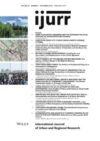Based on the example of Le Corbusier’s design for a network of urban thoroughfares in Buenos Aires, this article examines the role of concrete in the invention of a new material imaginary, where novel structures were used to architecturally delimit the expressivity of urban life. The article is structured in two parts. The first part examines how materiality has been repositioned as a site of and for politics. I chart three different strands of material politics prevalent in contemporary urban theory: material politics as (1) the inscription of metabolic infrastructures, (2) the disruption of the sensible and (3) the assembling of socio‐material entanglements. I then argue for the need to devise a definition of material politics that incorporates the notion of actualization and reflects the involvement of materials in the invention of and experimentation with alternative urban imaginaries. In the second part, I describe the assembly of Le Corbusier’s proposed concrete biology for Buenos Aires by examining three interrelated mechanisms: valorization, circulation and abstraction. To conclude, I emphasize the methodological value of using the instance of materialization as a form of tracing the historical emergence and transformation of alternative forms of problematizing and imagining the production of urban space.
Details
Written by:
Leandro Minuchin
Digital Object Identifier (DOI)
10.1111/j.1468-2427.2012.01203.x
About DOI
Read full article as PDF
Read full article as HTML
See the references for this article
